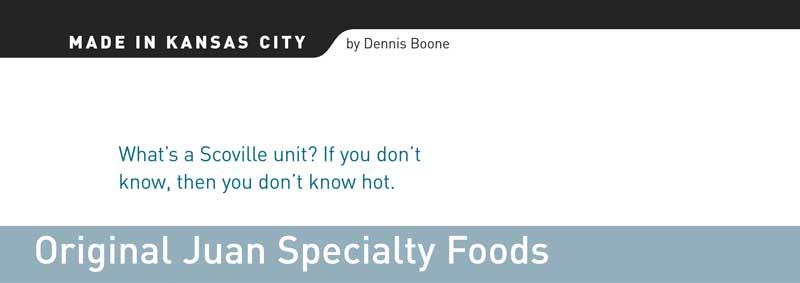

Joe Polo’s crew at Original Juan on Southwest Boulevard does know hot. They can tell you all about this unique standard of culinary measurement.
But before we wade into the science behind capsaicin, the stuff in chile peppers that sets off fire alarms on your tongue, let’s take a look at Polo’s operation on Southwest Boulevard in Kansas City, Kan.
It’s a tour worth taking, because this is what small-business success looks like, done right, and from the ground up. And not just because his 60,000-square-foot plant is the picture of organization, cleanliness, efficiency and tasteful décor. No, his 12-year-old company’s story is noteworthy for embracing the concept of change through rapid growth, taking command of the forces at work, and emerging bigger, stronger and better.
“The first seven years were like a honeymoon,” Polo said during a plant tour. “We felt we were invincible.”
Those years of triple-digit growth ran smack into the reality of an economy heading south in 2007, and 2008 wasn’t much better. Upticks of 5 and 6 percent were nice in a down economy, but that’s not what Polo’s business had grown used to.
So it was back to the drawing board, thanks in part to action plans forged with an alliance that put the brains of students from the Bloch School of Business at UMKC to work on a range of business-development issues. Along with some internal reorganization of a work force roughly 30 strong, Original Juan is again flirting with triple-digit growth for 2009.
A big part of that was reaching out to would-be sauce masters who wanted to launch product lines of their own. A sharpened focus on private-label production and co-packing brought that aspect of business from 10-15 percent of revenues up to 35-40 percent, he says.
The company also diligently hones the effectiveness of the Original Juan family of products—hot sauces, dessert sauces, barbecue sauces, flavored mayonnaise, even a specialty dubbed Cheesecake In a Jar are but a few. Polo, 49 continues to redefine his business, knowing it won’t be the same next year as it is this.
Every year, the bottom 20 percent of product-line performers gets a hard look and, most likely, an exit from the company’s portfolio. They are replaced by products being developed in Polo’s own test kitchen on site. “That way, all the things we produce can be winners,” Polo says. “It’s an on-going challenge.”
Polo still produces 80-gallon micro-batches of sauce for people trying to take their own flavors to market. “The small guys,” he says, “are the ones who keep me rolling. If I can spawn another dream, that’s my goal.”
Now, as for that Scoville business: It’s attributed to Wilbur Scoville, an American chemist who created a system nearly a century ago for gauging the intensity of peppers. It measures capsaicin, the heat source in chiles. One part capsaicin per million? That’s 15 Scoville units. Mere kid stuff to Polo’s crew. Which brings us to Da Bomb The Final Answer Hot Sauce at 1.5 million units. And onward and upward to The Source, at a staggering 7.1 million, billed by Polo and his staff as the hottest sauce on the planet.
And much more—a dozen product lines, with more than 140 total items sold in most every state, and in countries as far flung as Norway, Australia, Japan and Iceland.
“That variety is our competitive edge,” Polo says. “We’re nimble and quick, and we can turn something around and have it to market when the big companies need 18 to 24 months just to get something out of development.